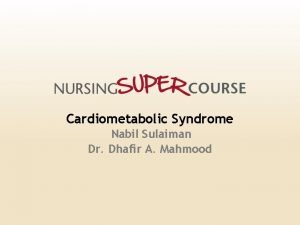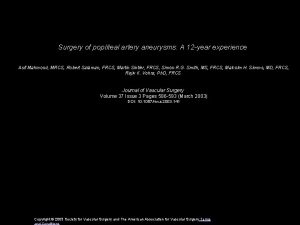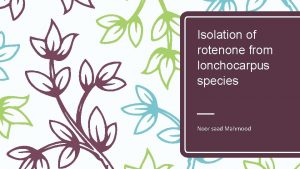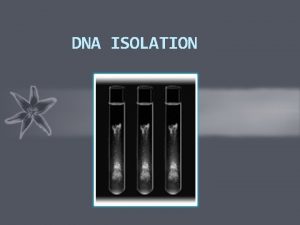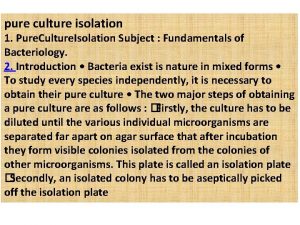ISOLATION OF PODOPHYLLOTOXI N NOOR SAAD MAHMOOD Introduction










- Slides: 10

ISOLATION OF PODOPHYLLOTOXI N NOOR SAAD MAHMOOD

Introduction : • Podophyllum (Wild Mandrake) consists of the dried rhizome and roots of Podopbllunt peltatum (Podophyllaceae)which is a perennial herb common in moist area in the eastern parts of Canada and the USA. • The Podophyllum resin is the crude alcohol extract of the plant's rhizome or underground root system and is essentially made up of 4 different components: podophyllotoxin, 4 demethylpodophyllotoxin, a-peltatin, and b-peltatin. • Podophyllotoxin is the most biologically active component and has been used for centuries by Native Americans for its medicinal properties • Podophyllotoxin’s synthetic derivatives display a wide selection in medical applications such as purgative, vesicant, antiviral, and antitumor agents. These derivatives include etoposide and

PHYSICAL AND CHEMICAL PROPERTIES: • The structure of podophyllotoxin was first elucidated in the 1930 s. Podophyllotoxin bears four consecutive chiral centers, labelled C-1 through C-4 in the following image. • The molecule also contains four almost planar fused rings. • The podophyllotoxin molecule includes a number of oxygen containing functional groups: an alcohol, a lactone, three methoxy groups, and an acetal. • Derivatives of podophyllotoxin are synthesized as properties of the rings and carbon 1 through 4 are diversified. • For example, ring A is not essential to antimitotic

Aromatization of ring C leads to loss Of activity, possibly from ring E no longer being placed on the axial position. In addition, the stereochemistry at C-2 and C-3 configures a trans-lactone, which has more activity than the cis counterpart. Mechanism of action • Podophyllotoxin and its derivatives display binding activity to the enzyme topoisomerase II during the late S and early G 2 stage. • For instance, etoposide binds and stabilizes the temporary DNA break caused by the enzyme, disrupts the reparation of the break through which the double-stranded DNA passes, and consequently stops DNA unwinding and replication

Cell cycle

Uses : For centuries, Native American tribes used the plant and its root for its medicinal, as well as poisonous properties. Various uses of the plant included: - • Anthelmintic to treat parasitic worm infections • Treat deafness • Treat snake bites • As a purgative and laxative • As a suicidal potion In the 1930 s, doctors in New Orleans started using podophyllotoxin for the treatment of genital warts. By 1942 the first description of this practice was published in medical

Uses : Podophyllotoxin possesses a large number of medical applications and can be used as a : • cathartic • Purgative • antiviral agent • vesicant • antihelminthic. • Additionally, podophyllotoxin and its derivatives are used as anti-tumor agents such as etoposide and teniposide.

Uses : • Under the trade names Condylox, a gel, and Wartec, a solution or cream, these synthetic derivatives (etoposide and teniposide) are used on the skin as a topical treatment of external genital warts, caused by some types of the human papillomavirus (HPV), and other warts. • Their anticancer activity has been heavily under study and used in various chemotherapies, including lung cancer, lymphomas, and genital tumors. • Its acts by preventing viral wart cells from dividing and multiplying. Eventually all the wart cells die and new healthy

Adverse Effects : - The most common side effects near the application site are skin reactions, including • burning • Redness • Pain • Itching • swelling. • Application can be immediately followed by burning or itching. • Small sores, itching and peeling skin can also follow. Neither podophyllin resin nor podophyllotoxin lotions or gels are used during pregnancy because these medications can be harmful to the fetus.

Procedure : • Extract powedered podophyllum emodi root (4 g) by stirring and heating with ethanol (40 ml ) for about 10 min cool and filter the mixture. • then re-extract the residue with further 100 ml of ethanol combine the extract and evaporate to about 20 ml. • pour the ethanolic solution into a water (100 ml) and extract with ethyl acetate (3× 50 ml) combine the extract and evaporate to dryness. • isolate the podophyllotoxin by preparative TLC (4 plates). • crystallize the product from ethanol allowing to crystallize at 0°C for several days.





